A few years ago, I looked up from my computer and saw my husband standing at my office door with a look of intense frustration and angst on his face. He appeared as if he was about to rant about something but he held it together.
Not knowing what could possibly have upset my steady and controlled husband, I asked what was wrong. Exasperated, he barked, “They want me to write an essay telling them how my past work experience would benefit the company. I’ve got over 20 years experience in this industry. How am I supposed to answer that question in 500 words!”
He was transitioning into a new phase of his career and needed to write this essay as part of the job application process. My husband is an engineer and, while a wizard at math and coding, it takes him an hour to write a paragraph in an email. He agonizes over the process of writing.
I knew I could help him, but the strategy that was perfect for him was a brainstorming and organizing technique that I’d been using for over a decade with students with learning disabilities as well as gifted students. I’d never introduced the strategy to an adult. Broaching the subject carefully, I suggested that he try this writing activity to organize his thoughts. I sat with him and walked him through the steps. Once he got going, there was no stopping him. It worked!
Don’t know how to start that Job Application Essay or School Assignment?
Starting the writing process is the most difficult part for most people. We learned how to organize our writing in school, but working that linear outline and starting with the introductory sentence is torturously slow for many of us.
Why? Because some of us are not linear thinkers or the words just don’t flow for us in sentence format all at once. Different people, learners, and writers work differently. Sometimes our working memory is so full of what we might write, we can’t seem to get started with the process of writing. That’s what we call, “writer’s block!”
Thankfully, there is a better way.
By using a simple clustering activity, and starting with what we know, we can write more effectively, more quickly, and with much less anxiety and frustration.
Here’s how the clustering writing strategy works…
Materials:
1. Unlined paper sized at 8.5 x 11 or larger.*
2. Lined paper cut into thirds (8.5 wide x 3.5ish)
3. Highlighters
4. Writing utensil
*Some people prefer to do this exercise on a tablet or laptop and use colored fonts instead of strips of paper. Each strip of paper would be substituted with text in a different color font.
Step 1. Brainstorm your ideas
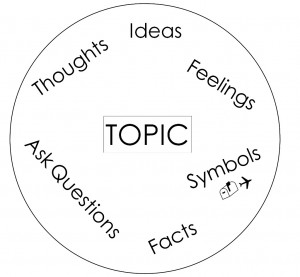
Download the full-size image below
B. Put the topic you are writing about in the middle of the circle.
C. Do a “brain-dump” and jot down all the keywords, facts, ideas, symbols, and questions that you have about the main topic. It’s OK to draw pictures or symbols of your thoughts in the circle. Anything that comes to mind to help you write a paper is viable. Do not censor your ideas at this phase of the process.
D. Don’t worry about spelling, grammar, or other conventions at this stage of the process. The purpose is to get your ideas out. Do the editing later.
For this example, let’s pretend that we are writing about a vacation. We can all relate to that idea and once you understand the process, you can use this technique for anything you need to write.
Step 2. Prioritize, Favorite, and Eliminate
A. Highlight the words, phrases, and images you might want to include in your writing.
B. Favorite your best ideas with a star; those you definitely want to include in your writing.
C. Cross out the words, phrases, images that you brainstormed but, on review, you decide don’t fit.
Step 3. Start writing in small steps
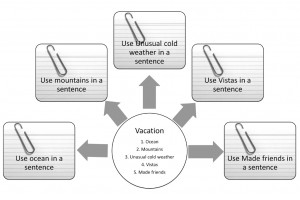
Download the full-size image below
B. Write a sentence about that word or phrase on a strip of paper. This will be your topic sentence for that idea. **DO NOT write more unless it flows effortlessly.**
C. Move onto the next favorite word and another strip of paper. Write a sentence about that idea on the strip of paper. Repeat the process for every idea you’ve starred.
D. Look at words that are highlighted but not starred. Decide whether you want to write about those ideas. If so, repeat the process above with those words.
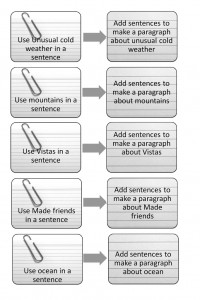
Download the full-size image below
A. Choose any strip of paper with a topic sentence that you feel you can elaborate upon. The order is not important. What’s important is that your ideas flow naturally and you are following your creative thought process rather than trying to constrain it into somebody else’s rules for writing.
B. When you have elaborated as much as you can on that topic sentence, choose another strip of paper with another topic sentence and repeat the process.
C. Repeat until you have at least three to five sentences on each strip of paper.
Step 5. Decide on the order for your paragraphs and connect them with transition words
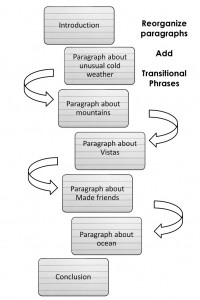
Download the full-size image below
A. Look at your paragraphs and decide on the best sequence.
B. Literally tape the paragraphs, in your preferred order, onto another piece of paper leaving about an inch of space in between.
C. In the space in-between the paragraphs, use transition words, and phrases* to connect the paragraphs.
*A handout with transition phrases is included at the end of this article.
Step 6. Write Your Introduction and Conclusion
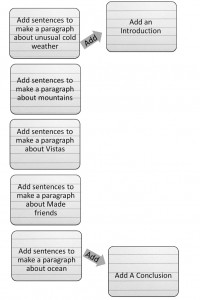
Download the full-size image below
Voila! You have written your first draft!
Step 7. Rewrite your draft
At this stage, the main ideas for the paper are in place. This is the time to wordsmith, proofread, edit, enhance, clarify, and refine your ideas.
Don’t forget to have someone else proofread it for you!
I have been using this clustering strategy for years and I’ve taught it to my students, my family, and my colleagues. It works well because it allows the writer to focus on the content and honor the flow of creative ideas rather than being constrained by rules that may not capitalize on your learning preferences.
The clustering writing strategy enables you to write a paper better and faster using this easy seven step productivity strategy! Stay tuned for more productivity tips for accelerating your success!
Download Your Free Copy of Clustering For Productivity With Full-size Images!
Transition Words for Writing a Paper
To Add:
And, again, and then, besides, equally, important, finally, further, furthermore, nor, too, next, lastly, what’s more, moreover, in addition, first (second, etc.)
To Compare:
Whereas, but, yet, on the other hand, however, nevertheless, on the other hand, on the contrary, by comparison, where, compared to, up against, balanced against, but, although, conversely, meanwhile, after all, in contrast, although this may be true
To Prove:
Because, for, since, for the same reason, obviously, evidently, furthermore, moreover, besides, indeed, in fact, in addition, in any case, that is
To Show Exception:
Yet, still, however, nevertheless, in spite of, despite, of course, once in a while, sometimes
To Show Time:
Immediately, thereafter, soon, after a few hours, finally, then, later, previously, formerly, first (second, etc.), next, and then
To Repeat:
In brief, as I have said, as I have noted, as has been noted
To Emphasize:
Definitely, extremely, obviously, in fact, indeed, in any case, absolutely, positively, naturally, surprisingly, always, forever, perennially, eternally, never, emphatically, unquestionably, without a doubt, certainly, undeniably, without reservation
To Show Sequence:
First, second, third, and so forth. A, B, C, and so forth. Next, then, following this, at this time, now, at this point, after, afterward, subsequently, finally, consequently, previously, before this, simultaneously, concurrently, thus, therefore, hence, next, and then, soon
To Give an Example:
For example, for instance, in this case, in another case, on this occasion, in this situation, take the case of, to demonstrate, to illustrate, as an illustration
To Summarize or Conclude:
In brief, on the whole, summing up, to conclude, in conclusion, as I have shown, as I have said, hence, therefore, accordingly, thus, as a result, consequently, on the whole.

Bring Susan to your campus!
Featured seminar – Differentiation Strategies to Reach ALL Learners in the Inclusive Classroom


